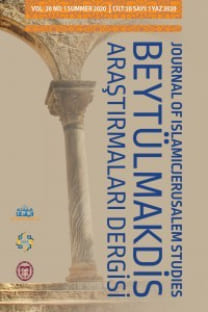Selahaddin'in Beytülmakdis'i teslim alma yolu -Sulh (antlaşma) ya da zorlama- ve bunun etkileri
Selahaddin'in Beytülmakdis'i teslim alma yolu -Sulh (antlaşma) ya da zorlama- ve bunun etkileri.
Anahtar Kelimeler:
Selahaddin, Beytülmakdis, antlaşma, kiliseler, Mescid-i Aksa, Haçlılar, Kutsal Kabir Kilisesi, Ayasofya, Salâhiyye Medresesi
The Surrender of Bayt al-Maqdis to Salah al-Din through Sulh (treaty) or ‘Unwah (by force) and its implications
The conquest of cities and regions in Islam involve special provisions related to the way Muslims deal with these cities and countries. For example, if a city is taken peacefully, or by Sulh, dealing with it differs from if it had been taken by force. Accordingly, when Umar ibn al-Khattab conquered Bayt al-Maqdis through peaceful surrender he gave its people an assurance of safety, giving them Aman over their lives, possessions, churches; this was the case for all cities taken in this way. As for the cities that were conquered both by force, or ‘Unwah, and also through Sulh at the same time, such as Damascus, then the half that was taken peacefully had the rule of peace, and the other half had the rule of force. Thus, the Muslims had the right to take everything in the latter and transfer the ownership of everything in it to the Muslims, including churches and other possessions. It became established that with regards to what was conquered by force, the possessions were either divided as spoils of war, or regarded as Waqf by the Muslims. In Salah al-Din's conquest of Bayt al-Maqdis, a number of questions were raised, including whether the conquest was by force or by peace, given that Salah al-Din transferred the use of some churches and facilities yet left other churches and did not change them. This article discusses how Bayt al-Maqdis was handed over to Salah al-Din, as he swore that he would only conquer it by force after he offered peace to its inhabitants several times before besieging it. The article also discusses the implications of this in terms of the handing-over terms and the changes that Salah al-Din made on the ground after liberating the city.
Keywords:
Conquest by force Peaceful conquest, churches, Bayt al-Maqdis, Salah al-Din, Crusades, Al-Aqsa Mosque, Holy Sepulchre, Hagia Sophia, Madrasah Salahiyah,
___
- Abu Munshar, Maher (2007). Islamic Jerusalem and its Christians: A History of Tolerance and Tensions, London: I.B.Tauris.
- Abu Shamah, A. (1997) al-Rawdatayin fi Akhbar al-Dawlatayin al-Nuriyah wal-Salahiyah. Beirut: Mu’asasat al-Risalah.
- Abu-Munshar, Maher (2005). The Position of Islamicjerusalem in the Negotiations between Sultan Salah al-Din and King Richard I “the Lion-Heart”. Journal of Islamicjerusalem Studies, vol.6 (1), 89-90.
- Abu-Munshar, Maher (2018). The Fate of Jerusalemites at the Hands of the First Crusade. Journal of Al-Tamaddun, v. 13, n. 1, p. 27-35.
- Abu-Munshar, Maher (2019). Islamicjerusalem in the Eyes of Salah Al-Din: A Critical Analytical Study of the Libation of the City from the Crusaders. Journal of Islamicjerusalem Studies, vol.19 (1), pp.65-80.
- Ahmad, R. (2017) al-Madrasah al-Salahiyah fi al-Quds. Amman: Dar al-Ma’mun.
- Al-Ansari, M. (2015) Tarikh Dawlat al-Akrad wal-Atrak. Isanbul: Azad.
- Al-Asbahani, I. (2004) al-Fath al-Qusi fi al-Fath al-Qudsi. Cairo: Dar al-Manar.
- Al-Balazuri, A. (1988) Futuh al-Buldan. Beirut: Dar wa-Maktabat al-Hilal.
- Al-Bindari, A. (1979) Sana al-Barq al-Shami. Cairo: Maktabat al-Khanqi.
- Al-Masri, A.Z. (2014) Athar al-Takamul al-Siyasi wal-Marifi fi Fath Bayt al-Maqdis. Journal of Islamicjerusalem Studies, vol.14. pp.47-69.
- al-Natsheh, Y. (2020) Maqam al-Nabi Dawud. in Discover Islamic Art, Museum With No Frontiers. Source: [http://islamicart.museumwnf.org/database_item.php?id=monument;isl;pa;mon01;35;ar&cp].
- Al-Nuwairi, S. (2008) Nihayat al-Arb fi Funun al-Adab. Cairo: Dar al-Kitab wal-Watha’iq al-Qawmiyah.
- Al-Qaradawi, Y. (2009) Fiqh al-Jihad: Dirasah Muqaranah li-Ahkamih wa-Falsafatih fi Duwu’ al-Kitab wal-Sunnah. Cairo: Maktabat Wahbah.
- Al-Qatfi, J. (2005) Kitab Ikhbar al-Ulama’ biAkhbar al-Hukamah. Beirut: Dar al-Kutub al-Ilmiyah.
- Al-Tabari, M. (1387AH). Tarikh al-Rusul wal-Muluk. Beirut: Dar al-Turath.
- Al-Ulaymi, M. (1999) al-Uns al-Jalil bi-Tarikh al-Quds wal-Khalil. Amman : Maktabat Dandis.
- Bioud, M.A. (2016) al-Kitabah fi Fadail Bayt al-Maqdis wa-Dawruha fi al-Harakah al-Marifiyah wa-Sinaat al-Wai fi Muwajahat al-Salibiyin. Journal of Islamicjerusalem Studies, vol.16. pp.1-17.
- El-Awaisi, A. (2019). Nazairyat wa-Namazaij Bayt al-Maqdis. Istanbul: Dar al-Usul al-Ilmiyah.
- Ibn al-Athir, I. (1997) al-Kamil fi al-Tarikh. Beirut: Dar al-Kitab al-Arabi
- Ibn Hajar al-Asqalani (n.d.) Kitab al-Dirayah fi Takhrij Ahadith al-Hidayah. Beirut: Dar al-Marifah.
- Ibn Khaldun, A. (n.d.) Tarikh Ibn Khaldun. Beirut: Dar al-Fikir.
- Ibn Shadad, B. (1994) Al-Nawadir al-Sultaniyah wal-Mahasin al-Yusufiyah. Cairo: Maktabat al-Khanqi.
- Ibn Wasil, M. S. (1957) Mufarij al-Kurub fi Akhbar bani Ayyub. Cairo: Dar al-Kitab wal-Watha’iq al-Qawmiyah.
- Lane-Poole, Stanley (1906). Saladin and the Fall of the Kingdom of Jerusalem, London: G.P. Putnam’s Sons, pp. 223-225.
- Muhammad, Z. (2012) Asil al-Tasmiyah li-Kanisat al-Qiyamah. Hawliyat al-Quds, vol.13, Summer 2012.
- Runciman, Steven (1952). A History of the Crusades: The Kingdom of Jerusalem and the Frankish East (1100 - 1187). Cambridge: Cambridge University Press, vol. 2, p. 463.
- Walmsley, Alan (2007) Early Islamic Syria: An Archaeological Assessment, London: Gerald Duckworth.
- ISSN: 1367-1936
- Yayın Aralığı: Yılda 2 Sayı
- Başlangıç: 1997
- Yayıncı: Beytülmakdis Çalışmaları Vakfı
Sayıdaki Diğer Makaleler
Gönüllü Savaşçılar ve Selahaddin’in Savaşlarına Katkıları
Selahaddin'in Beytülmakdis'i teslim alma yolu -Sulh (antlaşma) ya da zorlama- ve bunun etkileri
KUDÜS’ÜN KAYBI MÜSLÜMANLARIN HATASI MI? YOKSA HAÇLILARIN BAŞARISI MI?
Selahaddin'in Beytülmakdis'i teslim alma yolu -Sulh (antlaşma) ya da zorlama- ve bunun etkileri
Osmanlı Son Döneminden İsrail’in İşgaline Kadar Kudüs Kafeleri ve Ulusal Rolü
MEDRESELERİN DOĞUŞU VE KUDÜS’TEN YEDİ ASIRLIK BİR ÖRNEK: SALÂHİYYE MEDRESESİ
III. HAÇLI SEFERİNİN “KUDÜS’Ü KURTARMA” SÖYLEMİ VE ETRAFINDA ŞEKİLLENEN ALGI
